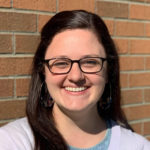This post was written by NCTE Ambassador Lindsay Schneider.
Books fill the space in my classroom—physically and metaphorically.
When students, parents, administrators, and colleagues alike enter room 1027, their eyes are immediately drawn to the (double-stacked and overflowing) bookshelves. Upon closer examination, their eyes are drawn to the wide diversity of books, characters, genres, storylines, and writing styles that fill the shelves and the pages.
But this semester, I have no physical classroom.
As I create new curriculum for virtual learning, my books sit alone in room 1027. The room where it all usually happens is quiet. Neither the dog-eared pages nor the shiny new covers will beckon students to become readers and whisk them away to new adventures.
My bookshelves have always been the heralds of an important message for those who enter my classroom: books matter. Your reading life matters. As a teacher, one of my most important aims is to help you find books that matter to you: books that serve as mirrors, windows, and sliding glass doors.
Choice reading has always been the cornerstone of the classes I teach. I believe my classroom provided students an imperative respite where they had protected time to read for pleasure every day. My students had daily, unfettered access and opportunity to explore and select books that capture their attention, their minds, and their hearts. Their engagement with the books in my classroom library allows them to consider and rehearse their responses to the complex situations, relationships, and people they encounter. Students begin to understand themselves, their peers, and the world around through a new lens, a lens through which they view problems critically and empathetically.
Driven by the resolve to provide students diverse reading experiences while developing lifelong readers who choose to read and an understanding that my reading directly affect my students’ reading lives, I have curated an always-growing, diverse classroom library which shapes my instruction, my classroom culture, my students, and who I am as a teacher and a learner.
This leaves me with unnerving questions:
- What comes next?
- Who am I as a virtual teacher?
- What must change this year and how do I remain true to the core values that have always driven my instruction?
- What happens to the books and, more importantly, the future readers?
Amidst a hurricane of ideas revolving around audiobooks, digital libraries, book talks, and covert book drop offs, I recall a hauntingly beautiful image—one of my favorite from all of literature—from Tim O’Brien’s The Things They Carried. O’Brien writes, “. . . it’s like being inside a book that nobody’s reading . . . an old [book]. It’s up on a library shelf, so you’re safe and everything, but the book hasn’t been checked out for a long time. All you can do is wait. Just hope somebody’ll pick it up and start reading.”
My books will not be checked out for a long time. They will sit on a shelf, waiting. But they are still there. There is hope. My classroom library is filled with diverse stories—fictional, fantastical, and true—because, just as Tim O’Brien concludes, I am trying to “save . . . lives with a story.”
And then, it hits me. The question is not how we get books in students’ hands.
The question is how do we fill our students’ lives with stories? How do we introduce them to a wide diversity of characters, genres, storylines, and writing styles? How do we let students explore the stories that are happening all around them right now and the stories happening within their own lives?
The classroom library is on its own but our students are not. Our students have stories that need to be told, and this year more than ever, teachers can guide them to tell and write and share those stories. Let’s all work together this year to use our classroom libraries in a new way: let’s pull short mentor texts from them so students can hear other voices but focus on developing their own. Of course our students need to read, but they also need to rise up and write.
Like O’Brien and Hamilton, what if we created virtual classrooms where students can write our way out this year? In this sequel to a “normal school year,” what if we include our students’ work at the forefront? What if the answer lies within their stories, not the already written books? They have had ample adventure in the past few months; let’s whisk them away to a new adventure where they are the ones teaching us.
My classroom library this year will be compiled of my students’ diverse stories and voices and experiences.
And this year, the first thing that catches someone’s eye when they visit my virtual classroom will be how my students’ voices and stories overflow into everything we do. My classroom library will be filled with new stories: ones of the bravery, heartache, joy, adventure, and more that my students possess.
Because the classroom library was never about the books. It was about the readers who found themselves there. It was always about the students. It is always about the students.

Lindsay Schneider teaches senior and freshman English in North Carolina. She is an avid reader and aspiring writer who is passionate about all things related to YA lit, building life-long readers beyond the walls of the classroom, integrating the arts into the English classroom, good coffee, baking, and the Wake Forest Demon Deacons. She is honored to serve as an NCTE Community Ambassador.
It is the policy of NCTE in all publications, including the Literacy & NCTE blog, to provide a forum for the open discussion of ideas concerning the content and the teaching of English and the language arts. Publicity accorded to any particular point of view does not imply endorsement by the Executive Committee, the Board of Directors, the staff, or the membership at large, except in announcements of policy, where such endorsement is clearly specified.

